+ Open data
Open data
- Basic information
Basic information
| Entry | Database: PDB / ID: 6nmi | |||||||||||||||
|---|---|---|---|---|---|---|---|---|---|---|---|---|---|---|---|---|
| Title | Cryo-EM structure of the human TFIIH core complex | |||||||||||||||
 Components Components |
| |||||||||||||||
 Keywords Keywords | TRANSCRIPTION / DNA repair / helicase / multiprotein complex | |||||||||||||||
| Function / homology |  Function and homology information Function and homology informationMMXD complex / core TFIIH complex portion of holo TFIIH complex / Cytosolic iron-sulfur cluster assembly / central nervous system myelin formation / positive regulation of mitotic recombination / hair cell differentiation / hair follicle maturation / nucleotide-excision repair factor 3 complex / nucleotide-excision repair, preincision complex assembly / ventricular system development ...MMXD complex / core TFIIH complex portion of holo TFIIH complex / Cytosolic iron-sulfur cluster assembly / central nervous system myelin formation / positive regulation of mitotic recombination / hair cell differentiation / hair follicle maturation / nucleotide-excision repair factor 3 complex / nucleotide-excision repair, preincision complex assembly / ventricular system development / CAK-ERCC2 complex / transcription factor TFIIK complex / embryonic cleavage / DNA 5'-3' helicase / adult heart development / UV protection / regulation of cyclin-dependent protein serine/threonine kinase activity / transcription factor TFIIH core complex / transcription factor TFIIH holo complex / G protein-coupled receptor internalization / cyclin-dependent protein serine/threonine kinase activator activity / nuclear thyroid hormone receptor binding / transcription preinitiation complex / RNA Polymerase I Transcription Termination / DNA 3'-5' helicase / regulation of mitotic cell cycle phase transition / RNA polymerase II general transcription initiation factor activity / transcription factor TFIID complex / erythrocyte maturation / 3'-5' DNA helicase activity / hematopoietic stem cell proliferation / spinal cord development / RNA Pol II CTD phosphorylation and interaction with CE during HIV infection / RNA Pol II CTD phosphorylation and interaction with CE / HIV Transcription Initiation / RNA Polymerase II HIV Promoter Escape / Transcription of the HIV genome / RNA Polymerase II Promoter Escape / RNA Polymerase II Transcription Pre-Initiation And Promoter Opening / RNA Polymerase II Transcription Initiation / RNA Polymerase II Transcription Initiation And Promoter Clearance / Formation of the Early Elongation Complex / Formation of the HIV-1 Early Elongation Complex / bone mineralization / mRNA Capping / intrinsic apoptotic signaling pathway by p53 class mediator / ATPase activator activity / DNA topological change / RNA Polymerase I Transcription Initiation / regulation of G1/S transition of mitotic cell cycle / hematopoietic stem cell differentiation / embryonic organ development / Tat-mediated elongation of the HIV-1 transcript / transcription elongation by RNA polymerase I / Formation of HIV-1 elongation complex containing HIV-1 Tat / Cyclin E associated events during G1/S transition / response to UV / Formation of HIV elongation complex in the absence of HIV Tat / Cyclin A:Cdk2-associated events at S phase entry / Cyclin A/B1/B2 associated events during G2/M transition / cyclin-dependent protein kinase holoenzyme complex / transcription by RNA polymerase I / RNA Polymerase II Transcription Elongation / Formation of RNA Pol II elongation complex / hormone-mediated signaling pathway / transcription-coupled nucleotide-excision repair / extracellular matrix organization / RNA Polymerase II Pre-transcription Events / positive regulation of smooth muscle cell proliferation / insulin-like growth factor receptor signaling pathway / DNA helicase activity / maturation of SSU-rRNA from tricistronic rRNA transcript (SSU-rRNA, 5.8S rRNA, LSU-rRNA) / determination of adult lifespan / post-embryonic development / nucleotide-excision repair / chromosome segregation / TP53 Regulates Transcription of DNA Repair Genes / transcription initiation at RNA polymerase II promoter / transcription elongation by RNA polymerase II / promoter-specific chromatin binding / RNA Polymerase I Promoter Escape / cellular response to gamma radiation / G1/S transition of mitotic cell cycle / response to calcium ion / NoRC negatively regulates rRNA expression / Dual Incision in GG-NER / Transcription-Coupled Nucleotide Excision Repair (TC-NER) / Formation of TC-NER Pre-Incision Complex / multicellular organism growth / spindle / Formation of Incision Complex in GG-NER / Dual incision in TC-NER / Gap-filling DNA repair synthesis and ligation in TC-NER / Cyclin D associated events in G1 / intracellular protein localization / RUNX1 regulates transcription of genes involved in differentiation of HSCs / 4 iron, 4 sulfur cluster binding / response to oxidative stress / double-stranded DNA binding / 5'-3' DNA helicase activity Similarity search - Function | |||||||||||||||
| Biological species |  Homo sapiens (human) Homo sapiens (human) | |||||||||||||||
| Method | ELECTRON MICROSCOPY / single particle reconstruction / cryo EM / Resolution: 3.7 Å | |||||||||||||||
 Authors Authors | Greber, B.J. / Toso, D. / Fang, J. / Nogales, E. | |||||||||||||||
| Funding support |  United States, United States,  Switzerland, 4items Switzerland, 4items
| |||||||||||||||
 Citation Citation |  Journal: Elife / Year: 2019 Journal: Elife / Year: 2019Title: The complete structure of the human TFIIH core complex. Authors: Basil J Greber / Daniel B Toso / Jie Fang / Eva Nogales /  Abstract: Transcription factor IIH (TFIIH) is a heterodecameric protein complex critical for transcription initiation by RNA polymerase II and nucleotide excision DNA repair. The TFIIH core complex is ...Transcription factor IIH (TFIIH) is a heterodecameric protein complex critical for transcription initiation by RNA polymerase II and nucleotide excision DNA repair. The TFIIH core complex is sufficient for its repair functions and harbors the XPB and XPD DNA-dependent ATPase/helicase subunits, which are affected by human disease mutations. Transcription initiation additionally requires the CdK activating kinase subcomplex. Previous structural work has provided only partial insight into the architecture of TFIIH and its interactions within transcription pre-initiation complexes. Here, we present the complete structure of the human TFIIH core complex, determined by phase-plate cryo-electron microscopy at 3.7 Å resolution. The structure uncovers the molecular basis of TFIIH assembly, revealing how the recruitment of XPB by p52 depends on a pseudo-symmetric dimer of homologous domains in these two proteins. The structure also suggests a function for p62 in the regulation of XPD, and allows the mapping of previously unresolved human disease mutations. | |||||||||||||||
| History |
|
- Structure visualization
Structure visualization
| Movie |
 Movie viewer Movie viewer |
|---|---|
| Structure viewer | Molecule:  Molmil Molmil Jmol/JSmol Jmol/JSmol |
- Downloads & links
Downloads & links
- Download
Download
| PDBx/mmCIF format |  6nmi.cif.gz 6nmi.cif.gz | 558.7 KB | Display |  PDBx/mmCIF format PDBx/mmCIF format |
|---|---|---|---|---|
| PDB format |  pdb6nmi.ent.gz pdb6nmi.ent.gz | 445.3 KB | Display |  PDB format PDB format |
| PDBx/mmJSON format |  6nmi.json.gz 6nmi.json.gz | Tree view |  PDBx/mmJSON format PDBx/mmJSON format | |
| Others |  Other downloads Other downloads |
-Validation report
| Summary document |  6nmi_validation.pdf.gz 6nmi_validation.pdf.gz | 1.4 MB | Display |  wwPDB validaton report wwPDB validaton report |
|---|---|---|---|---|
| Full document |  6nmi_full_validation.pdf.gz 6nmi_full_validation.pdf.gz | 1.4 MB | Display | |
| Data in XML |  6nmi_validation.xml.gz 6nmi_validation.xml.gz | 85.2 KB | Display | |
| Data in CIF |  6nmi_validation.cif.gz 6nmi_validation.cif.gz | 130.3 KB | Display | |
| Arichive directory |  https://data.pdbj.org/pub/pdb/validation_reports/nm/6nmi https://data.pdbj.org/pub/pdb/validation_reports/nm/6nmi ftp://data.pdbj.org/pub/pdb/validation_reports/nm/6nmi ftp://data.pdbj.org/pub/pdb/validation_reports/nm/6nmi | HTTPS FTP |
-Related structure data
| Related structure data |  0452MC  0587C  0588C  0589C  0602C  0603C  0604C M: map data used to model this data C: citing same article ( |
|---|---|
| Similar structure data | |
| EM raw data |  EMPIAR-10430 (Title: Phase-plate cryo-EM of human TFIIH / Data size: 9.2 TB EMPIAR-10430 (Title: Phase-plate cryo-EM of human TFIIH / Data size: 9.2 TBData #1: Unaligned movies of human TFIIH, using the Volta phase plate, dataset 1 [micrographs - multiframe] Data #2: Unaligned movies of human TFIIH, using the Volta phase plate, dataset 2 [micrographs - multiframe] Data #3: Unaligned movies of human TFIIH, using the Volta phase plate, dataset 3 [micrographs - multiframe] Data #4: Unaligned movies of human TFIIH, using the Volta phase plate, dataset 4 [micrographs - multiframe] Data #5: Unaligned movies of human TFIIH, using the Volta phase plate, dataset 5 [micrographs - multiframe] Data #6: Unaligned movies of human TFIIH, using the Volta phase plate, dataset 6 [micrographs - multiframe]) |
- Links
Links
- Assembly
Assembly
| Deposited unit | 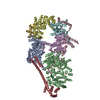
|
|---|---|
| 1 |
|
- Components
Components
-General transcription and DNA repair factor IIH helicase subunit ... , 2 types, 2 molecules AB
| #1: Protein | Mass: 74233.492 Da / Num. of mol.: 1 / Source method: isolated from a natural source / Source: (natural)  Homo sapiens (human) / Cell line: HeLa / References: UniProt: P19447*PLUS, DNA helicase Homo sapiens (human) / Cell line: HeLa / References: UniProt: P19447*PLUS, DNA helicase |
|---|---|
| #2: Protein | Mass: 86417.766 Da / Num. of mol.: 1 / Source method: isolated from a natural source / Source: (natural)  Homo sapiens (human) / Cell line: HeLa / References: UniProt: P18074*PLUS Homo sapiens (human) / Cell line: HeLa / References: UniProt: P18074*PLUS |
-General transcription factor IIH subunit ... , 5 types, 5 molecules CDEFG
| #3: Protein | Mass: 57789.000 Da / Num. of mol.: 1 / Source method: isolated from a natural source / Source: (natural)  Homo sapiens (human) / Cell line: HeLa / References: UniProt: P32780*PLUS Homo sapiens (human) / Cell line: HeLa / References: UniProt: P32780*PLUS |
|---|---|
| #4: Protein | Mass: 52245.156 Da / Num. of mol.: 1 / Source method: isolated from a natural source / Source: (natural)  Homo sapiens (human) / Cell line: HeLa / References: UniProt: Q92759 Homo sapiens (human) / Cell line: HeLa / References: UniProt: Q92759 |
| #5: Protein | Mass: 39609.098 Da / Num. of mol.: 1 / Source method: isolated from a natural source / Source: (natural)  Homo sapiens (human) / Cell line: HeLa / References: UniProt: Q13888*PLUS Homo sapiens (human) / Cell line: HeLa / References: UniProt: Q13888*PLUS |
| #6: Protein | Mass: 34416.008 Da / Num. of mol.: 1 / Source method: isolated from a natural source / Source: (natural)  Homo sapiens (human) / Cell line: HeLa / References: UniProt: Q13889 Homo sapiens (human) / Cell line: HeLa / References: UniProt: Q13889 |
| #7: Protein | Mass: 8060.362 Da / Num. of mol.: 1 / Source method: isolated from a natural source / Source: (natural)  Homo sapiens (human) / Cell line: HeLa / References: UniProt: Q6ZYL4 Homo sapiens (human) / Cell line: HeLa / References: UniProt: Q6ZYL4 |
-Protein , 1 types, 1 molecules H
| #8: Protein | Mass: 35873.965 Da / Num. of mol.: 1 / Source method: isolated from a natural source / Source: (natural)  Homo sapiens (human) / Cell line: HeLa / References: UniProt: P51948 Homo sapiens (human) / Cell line: HeLa / References: UniProt: P51948 |
|---|
-Non-polymers , 2 types, 7 molecules 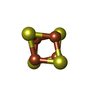


| #9: Chemical | ChemComp-SF4 / |
|---|---|
| #10: Chemical | ChemComp-ZN / |
-Details
| Has protein modification | Y |
|---|---|
| Sequence details | The full sequence for General transcription factor IIH subunit 1, p62 ...The full sequence for General transcription factor IIH subunit 1, p62 MATSSEEVLL |
 Movie
Movie Controller
Controller



 UCSF Chimera
UCSF Chimera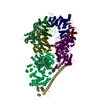


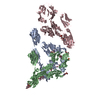

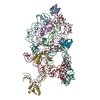
 PDBj
PDBj



















